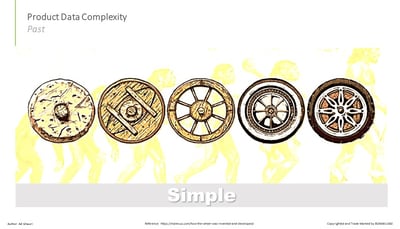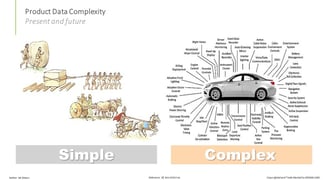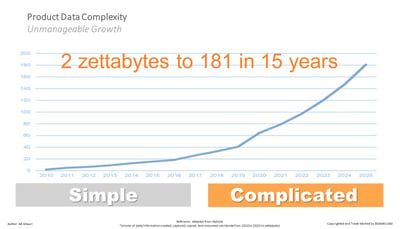Federated Systems of Systems (FSoS) Module
Understand Your Product Data and Processes to recognize relevant complexities


Streamline your Data and Processes for better outcomes
Product Data Complexity of the Past
In context of Product and its lifecycle management, we will use an example of a wheel that everyone can easily understand and relate to. Humanity invented a wheel around Neolithic era and somehow formulated design thinking i.e. how to make it, and what materials to use in it. The wheel, since then, has continued to evolve, and today it has become a complex system. Perhaps in the Neolithic era, all design thinking that is equivalent to today’s virtual representation of the physical wheel, was in the mind of one person and the need for sharing and transmitting the design was not as relevant as it has become today.
Product Data and Process Complexities of Present and future
Today a wheel is used in many applications and is a critical element of many systems definitions. For instance, a wheel is directly a part of TPMS, Suspension, Transmission, Braking, and many other control systems of the vehicle. With the advancements in smart and autonomous vehicles, the wheel and its direct systems, have become an important element of other indirect systems, like cloud, where critical KPIs are evaluated and streamed into clustered knowledge bases. AI algorithms then have the ability to simultaneously analyze and repurpose this clustered information, which can be used for traffic control and coordination, and in conjunction with more complex, Systems of Systems (FSoS), such as smart cities. Here both references to systems are intentionally plural. So, we have come, a long way from a wooden wheel to a very complex Systems of Systems (FSoS).
Off course, we talked about the first wheel, which was simple, but it was not perfect either. It had to be continuously improved to become fragment of a very complex system today. These complexities are requiring more validations, across both direct and indirect dependent systems. The wheel design model has to fit into a much larger picture and therefore early collaboration is required, so that other dependent functional domains, can start as early as possible, to reflect their interfaces with the wheel. All of these collaborations require concurrent engineering; otherwise we would be rolling back to a serialized process of the past.
Product Data and Process Complexities and its Unmanageable Growth
With the evolution in design and manufacturing processes, the amount of data continues to grow exponentially. Some of this unprecedented data growth is due to redundant and multiple versions of partial truth, as well as lack of continuity of clusters of data from one discipline and phase to the next. Each phase and discipline in some cases makes copies of the critical clustered data leaving behind the actual knowledge federations. This in turn even becomes a much larger problem as the contractors and sub-contractors make additional copies of this data. These multiple versions of partial truth require further reconciliations across all stakeholders that in fact could have been connected through Single Filament of Knowledge. So all these additional layers of redundancies are causing data volume to grow as well.
We know that many analysts are suggesting that we have produced more than 90% of all data ever produced in the history of humanity, in last 2 years alone. Off course with more data comes many problems. The discovery of data, its storage, its retention, its reuse, its security, and its loss are just the tip of the iceberg. In context of product data and its lifecycle, within Design Engineering, Manufacturing, and Supply Chain, the amount of data generated and consumed is growing rapidly. With the rate of change of customer specific configurable products, the product design complexity is growing significantly. Design and manufacturing simulations are becoming faster and more predominant , but are many times larger than their CAD files counterparts. Based on what we know today, we can assume that the Design and Manufacturing data may also double in size much more rapidly than ever before.
Product Data and Process Complexities require Systems of Systems (FSoS) approach
The wheel system analogy is modest compared to complexities of Process industry. However, with some effort we can surely scale the systems of systems idea on a much more complex domain such as a process plant or refinery or discrete manufacturing organization. Today it is possible to start with a 3D design model representation, which can easily simulate, both the Construction of the plant, and the production of the configurable products that this plant will produce, even before the plant Front End Engineering and Design (FEED) stage is completed, and that is the main value proposition. In addition, as the plants become smarter and more connected, process industry can realize more flexibility to produce a variety of different products in the same Plant with optimum up-times and throughputs.
Off course, this will require automation of the production processes and better transmission of product data across the manufacturing supply chain to enable production of smaller lots that adapt to customer specific requirements. Product Lifecycle Management (PLM) can also increase productivity through application of Industry 4.0 principles by using advanced analytics in reliability centered predictive maintenance strategies.
#1 Both Process and Discrete manufacturing can avoid unplanned shutdowns and factory machine failures by 50% while increasing overall production by 20%.
Collaborative and concurrent approvals across Systems through FSoS
In process industry and discrete manufacturing, there are many data handovers which add unwanted redundancies that cause delays. FSoS enables direct and real time access to design data cross the entire supplier and vendor chain producing a huge positive impact on the time to market (or time to first oil). FSoS enables a federated Systems of Systems connections across the entire capital project, its stakeholders including EPC supply chain, regulatory bodies, and Operators , ensuring that the are on the same page all the time, while all reviews and approvals can happen online within FSoS.
Capital Projects and Asset alignment through FSoS
As large capital projects are executed and later transitioned into operations, how powerful would, it be to have the forensic ability to trace back to the original designs for any asset or BOM. When there are any failures, breakdowns, suboptimal performance, or any variety of upset conditions, the ability to get at the root of the problem effectively and quickly is paramount in the volatile manufacturing domain. We often discuss the digital twin… it’s the digital thread associated with each asset or its BOM, that is important to ensure that engineering, construction and installation work breakdown and completion translates into a detailed accountable plant breakdown structure. Capital projects along with their assets must be aligned, both virtually and later physically, from Cost, Work, and Schedule Breakdown structures perspectives, to avoid anything upsetting happening in the first place. A fully digitalized FSoS is a great way to start such an alignment.
Some questions on pursuit towards continuous improvement of System's federation
Some critical questions that every leader may be asking every day:
1. How does my company stay competitive?
2. How can I make my Design more accurate?
3. How can I minimize design and manufacturing flaws
4. How can I identify design and manufacturing flaws early in my product development lifecycle?
5. What can I do to make collaboration between engineering, manufacturing, and sustainment smoother and livelier?
6. What steps do I take to make my design (meaning virtual model), reflect the production (meaning physical model), and vice versa?
7. How do I ensure that the changes propagate bi-directionally, across the two virtual and physical worlds without hesitation?
How do I enable traceability and leverage key learnings, starting from understanding customer requirements, all the way to measuring their experience in one filament of knowledge?
Moreover, we must admit that all these challenges are not simply addressed by FSoS, but by the process of better integrating Product Data and Its Processes, into the big canvas of global engineering, manufacturing, and logistical operations.
Copyrighted and Trade Marked by BOMAtic360




References #1: Source (ScienceDirect - The challenge of integrating Industry 4.0 in the degree of Mechanical Engineering)
